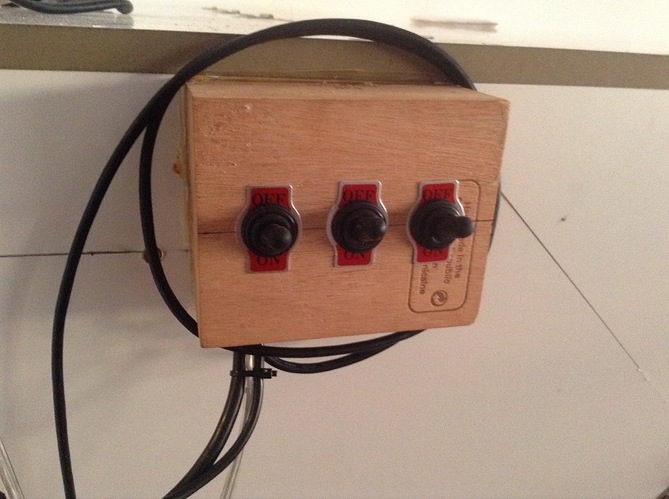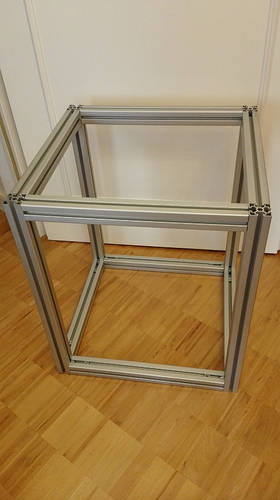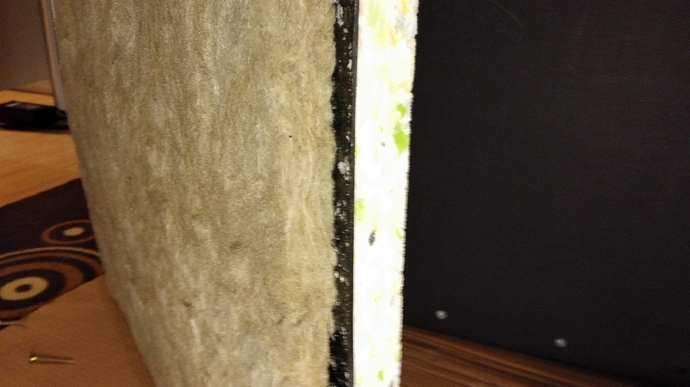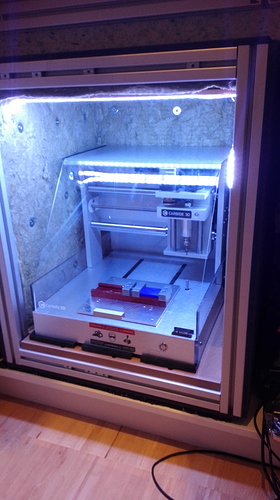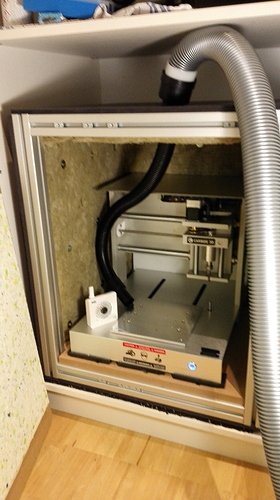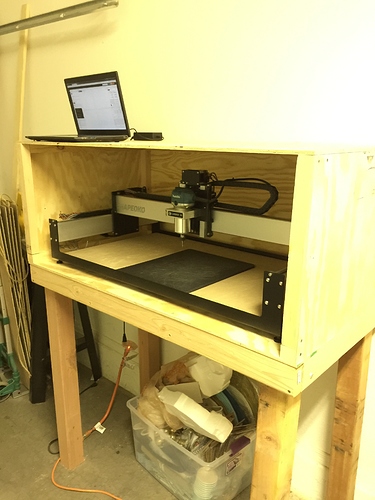Thanks for sharing, researching for my enclosure build. What foam did you use and what is the fiber tape on the edge? There are so many “sound sealing” edge treatments. I’ve read so many different type of foam and each description degrades what the other says. A real example like yours is so important. When you test it with a router are you able to measure the decibels? A sound clip helps too. Thanks alot. Looks like you put the emphasis on effective.
i will try to make the test as soon as possible, with a video and sound test . but i dont have any decibels measurements… for my enclosure it s not finish, and the ruber fiber tape is only for protect the sound foam.
New improvement ! First cut Done : very quite, no Body complain ! But no vacuum was plugged …
other things: routing all the switch in the same cigare box, now drawing some diagram to make it identified!Hi Guys,
I read so many posts and learned a lot about building a enclosure and wanted to share the (almost) final result before I never do it because I am too busy machining great stuff ;). I also had Mark providing some very useful tipps, as the first version of the enclosure did not provide the expected sound suppression. Thanks to all for the very helpful posts.
My goal: I have the Nomad standing in my appartment with kids and wife, so I aimed for maximal sound suppression within a given space (I hide the encasing in a wardrobe)
Base Frame…build with 45mm Bosch Alu Profiles
Included extra profiles for the bottom to minimize vibrations…also added “Sonorock Plus” from Rockwool…as the Quiet Fiber stuff ins not available in Europe (at least i could not find a supplier…). Bottom is made of 18mm MDF plate. Black cover around the case is 10 mm MDF plates.
used 3 layers of isolation…
1.) 20mm Rockwool Sonorock Plus
2.) 2mm “Bitumen Plate”…very heavy stuff
3.) 20mm “foam with glue” / “Verbundschaumstoff”
integrated some LED’s…the Nomad rests on Sorbothane 30 pads…3 Stripes and the front…3 at the back
Sucction: 35mm from the dust head (not visible in that picture) to the top…then 50mm from the top to a Festool CT 26…the 35mm tube is directly connected to the 50mm tube…the foam layer i use is forming a pretty tight fit around the 35mm tube…so I can not see and hear any air going in there…i also added a seperate air intake hole (not visible)…i will use a muffler to cover the air intake if there is a sound suppression problem…but so far the festool is the one making the greatest noise 
I also discarded the idea of a window as the noise suppression was far below what I expected…so I fully plug in the cover you can see…the “glue of foam” makes a very tight fit when i plug it in (i really need to push to get the air out, which is a great sign)…doing the homeing cycle of the nomad without the plug gives me 58db of max noise level…with the plug i measure only 45db, which is what I need…
I plan to add a camera at the back of the Nomad, so that I can see whats going on within the dust head.
What I learned during the process:
- One looses a lot of noise suppression with a window
- Make the bottom stable as shown with a heavy 18mm MDF Plate
- Use different layers and layer types
- A Festool CT 26 is a great investment even if you do not plan to install a dust head and constant suction
- Use the feedback of the community before you start

I hope that helps, happy to take any questions!
Markus
Old link broken: anyone wanting to see my design for an enclosure: http://www.makealittlemore.com/2016/02/10/diy-cnc-router-enclosure/
Hi Everyone,
Here I designed and built an enclosure for my SO3, wrote an Instructable, and forgot to post it here where it belongs!
Hello Everyone. Been watching this thread and planning for like 5 months, excited to finally post something. Here’s my super basic enclosure. Built a sturdy platform and a box to go on top. Used some old blankets for sound dampening, cut them to line the walls. Between the wood and the lining the sound dampening is considerable. Still looking at getting some high density foam. Apart from that the only thing left is making a front door. Haven’t had the tools to cut the window.
Anyone have any thoughts on ventilating to make sure nothing overheats? I wondered if that is a fear with an insulated enclosure?
My thought on an enclosure is that some reasonable portion of the heat should get vented out w/ the dust collection — currently trying to work something up for my Nomad…
@WillAdams I’m in a similar boat, long runs leave it quite toasty in there, so I’m working on figuring out a good ventilation/intake setup before I cut some holes in my enclosure for vacuum hoses…
-Jonathan
An enclosed SO3 should be vented since you are pumping in up to 1000 watts. However, I can’t imagine not using dust collection while cutting. When enclosed the fine dust will be very hard on bearings if you don’t use dust collection of some sort. Plus, adding dust collection completes the beauty of having an enclosure… low noise and practically no dust or cleanup.
Markus, your enclosure build looks like just what I need. I also live in an apartment and need to keep the noise under control to avoid upsetting my family and neighbours. Would you be able to share the dimensions of the enclosure with me and let me know if you’d tweak any part of the design now that you’ve been using it for a while. Thanks in advance.
I’ve finished an enclosure for my Nomad that will keep the noise down and control the dust. Thanks to everyone here on the forum for ideas and especially to @mbellon for the dust head design. The walls are a 5-layer composite panel of bamboo, MLV and Masonite with green glue holding them all together. With this stackup, I’m getting about 32Db of noise suppression.
I also routed the vacuum hose underneath the mill in the base of the enclosure so that I wouldn’t have to drill holes through the side panels and to reduce the bend radius to the dust head. I saw a comment above about reducing heat within the enclosure and I’ve been able to run my Nomad for 8+ hours with the vacuum running without noticeable heat buildup. Running it with the vacuum off would be a problem so I have to remember to turn it on every time.
I installed a web cam and LED lighting so that I can watch the machine from my computer or phone while it’s cutting.
I tried to keep the BOM cost down but using 2x2s for the frame but, in the end, it was about $400 dollars. Half of this was the bamboo, green glue and webcam, but I think they were worth the extra cost!
How many db is the dust collector. Is it the Festool?
@Remmy - EXCELLENT, AWESOME WORK!
When I build my enclosure I used what I had around - T-Slot and Alumalite - and resorted to two layers of sound absorbing foam to kill the sound better (heavy and light).
You’re using MASS in the walks to kill sound… the first and most important factor to address. Next, you’re using air spaces in the wall, also important.
A two MINOR comments:
-
Placing light foam inside an enclosure - designed for sound suppression - can improve things even
more.This is because the flat walks of the enclosure can be a fundamental or overtone of frequencies from
the machining… and things can actually get LOUDER due to resonance. The light, sound defusing
foam breaks up that process and prevents this from happening. -
The base idea with the hose underneath is EXCELLENT! That said, you’ve created a Dirichlet
problem. You’ve got the floor supported only around the edges and this makes it easy to vibrate.
Basically, a drum.If possible, it would be good to have some supports under the floor material. No matter how strong
and heavy the floor material is, it can vibrate. Some supports dramatically reduce the vibration.
Very clean, well designed, and cost effective. Your door solution is better than mine as you door seal is via compression. Mine have only minor contact and compression.
mark
P.S.
When CNC machine enclosures are involved, it’s very common for the air elements (i.e. vacuum and pressure) to DOMINATE the soundscape. The solution - use an enclosure! With vacuum and pressure the devices need air flow to feed as well as to cool so the enclosure design is similar except that they need input or output mufflers. Enclosure mufflers from vacuum and compressors are cheap and easy.
Daniel,
Happy to provide some additional information.
I attached a .pdf that I have off the shelve, so that you can see some of the things I used besides the profiles. It was done quick and dirty and it is propably not self-explanatory so I state the most important dimensions here again. (I also made some minor changes to the innitial design, the pictures show the latest design). Sorry for metric dimensions I am based in Europe 
Dimension inside are (that is the space that is available)
Height: 600mm
Depth: 470mm
Width: 500mm
Dimensions outside are (that is the space you need in your flat)
Height: 600mm + 2x45 (profile) +2x10 (MDF plate) = 710mm
Depth: 470mm + 2x45 (profile) +2x10 (MDF plate) = 580mm
Width: 500mm + 2x45 (profile) +2x10 (MDF plate) = 610mm
What I would tweak:
I was limited on the Depth dimension, because I put the enclosure inside a cabinet/Wardrobe. Without that limitation, I would add 60-80mm more depth to leave enough air space between the Nomad and the enclosure. If you use a “plug” like me, 60mm are enough, if you use a nice window, I would go for the 80mm.
The rest works just fine for me. I am very satisfied with the suppression, I can run a job in the evening when the kids are asleep without any problems. However, I can not use the Festool for that “silent mode”, as the Festool is just too loud for that, so evening time is more finishing time with only light material removal  Maybe I also build an enclosue for the Festool, but I focus on CAD/CAM for now
Maybe I also build an enclosue for the Festool, but I focus on CAD/CAM for now 
Happy go answer further questions if you have any
Markus
Presentation2_v0.2.pdf (1.2 MB)
Yeah it’s a CT Mini and the noise ranges from 62db to about 70db depending on the level of suction. That is now the loudest part of the system so I should probably figure out how to muffle that next!
Markus, this is incredibly helpful. Danke schön 
The Nomad doesn’t have much power so it may not need to be vented. However, your vacuum is doing the venting so that’s not an issue either way.
My comment about venting was related to the SO3. It draws 10x as much power as the Nomad so it gets hot inside of an unvented enclosure.
Poor man’s adventure in “soundproofing” enclosure:
I’ve researched soundproofing and discovered I can’t afford the proper material. So here’s how I’ve accomplished 22 dbs of sound reduction. My enclosure is 2 sections, Shapeoko 3 and than the kirby vacuum cleaner. The makita router is only 85 bds although that’s not cutting. The kirby is 101 dbs. First I’ll describe the enclosures. The 2x4 frame and ext plywood pieces are all decoupled from each other with rubber tape (door / window opening sealant tape i had ) so to eliminate sound from traveling from member to member. Inside is 2 layers of 1/2 sheetrock. Soundless sheetrock has a layer of viscus elastic between the layer, so I used ductwork foil foam tape (12" x 15’ roll) (known as poor man’s dynamat), I wrapped the inner layer with the foil foam to decouple it from the plywood and the interior layer of sheet rock. I also left all edges of the sheet rock separated a little and sealed the gaps with silicone caulk. Same with the vacuum enclosure. I built a baffled intake/ exhaust for the vacuum and cut ports from the cnc enclosure to the vacuum enclosure so the vaqcuum’s exhaust blows into the cnc “box”. I also redirected the vacuum’s hose to the bag inside the cnc box so the vacuum recirculates clean air back into the cnc box after vacuuming the dirty air out (1 micron filter bag). It’s not pretty but does have a 22 decible reduction. Now my kids are buying a new couch and I’ll have lots of upholstery foam available. Do you (whoever is reading) think encasing the vacuum’s enclosure with the foam on the outside will benefit me at all. I’ll try it in a couple weeks. Also (hey Mark) I supported the bottom of the enclosure with an extra vertical 4x4 in the middle of the bottom to eliminate the “drum” problem you mentioned earlier. The floor is 1/2 inch of self leveling cement and padded with 1/2" play mat rubber padding. Flat and level in one step. Still need to built the door, I have a sheet of plexiglass and plan to triple pane the door, why not? I have a double garage door seal around the door opening to seal the future door. Everything is built from what I have except the foil foam wrapping. Money is very elusive and seems to avoid me so all I can do is what I can do, so I did. I can always trash the vacuum compartment since it’s not an investment just a use for scrap material laying around. That’s if I find a cheap impeller blower on craglist. The shapeoko 3 enclosure will be better soon as it’ll have a borescope camera mounted on the dust shoe which has a swivel mounted vacuum hose so the hose doesn’t bind up. Right now I have to clean up the mess so I can run the new elec circuits and switches for the system. Than the S03 can move in and test it’s neighbor’s patience. 22 db reduction is nice but I need less noise. Thanks for reading.
So here’s how I’ve accomplished 22 dbs of sound reduction…
Nicely done! I’ve always said that a good enclosure can be made on almost any budget.
Sheetrock is more than acceptable, especially when there is a flexible layer in between (Green Glue is commonly used).
The kirby is 101 dbs
Vacuum cleaners are effective but the fine particles will often dramatically reduce their life. It’s very important that the exhaust be filter otherwise this can INCREASE human exposure to dangerous particulates. If one cannot filter, consider exhausting the air outside the building.
I built a baffled intake/ exhaust
Air going and air going out “mufflers” are very important for compressor and vacuum sound reduction. Sounds like you’re approach is very good.
(1 micron filter bag)
HEPA filters are on the order of 0.5 microns. A 1 micron filter is quite good… and often cheaper. Remember that your recycler system is going to quickly fill the filter. Carefully and slowly, bag it, take it outside and wash it out. Let it dry thoroughly before using it again.
Do you (whoever is reading) think encasing the vacuum’s enclosure with the foam on the outside will benefit me at all.
Foam that works well for sound is different than many other types of foam. My opinion is that using furniture foam would be a small improvement at best.
I have a sheet of plexiglass and plan to triple pane the door, why not?
Windows are often an easy way for sound to escape. Double and triple panes are an excellent idea to reduce the easy of sound escape. Switching to solid walls and a camera - given that cameras aren’t expensive now-a-days, is a better way to keep the sound in.
I’ll try it in a couple weeks. Also (hey Mark) I supported the bottom of the enclosure with an extra vertical 4x4 in the middle of the bottom to eliminate the “drum” problem you mentioned earlier.
The Dirichlet problem is very real, but it’s affects vary with the materials used, the scale involved (distances), and frequencies involved.
Not long ago I had someone contact me about a CNC enclosure not being anywhere near as quiet as expected, particularly at the lower frequencies. I reviewed the enclosure and asked that two cross members go under the deck that the CNC rested on. Once done, the results were quite satisfactory, many decibels less.
mark
